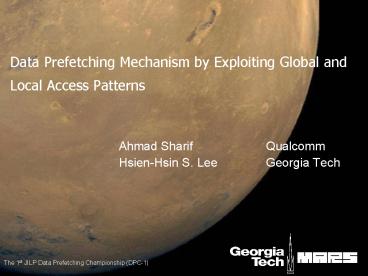Data Prefetching Mechanism by Exploiting Global and Local Access Patterns - PowerPoint PPT Presentation
Title:
Data Prefetching Mechanism by Exploiting Global and Local Access Patterns
Description:
Data Prefetching Mechanism by Exploiting Global and Local ... Traversing a tree laid out as an array. low memory address. high memory address. History Buffer ... – PowerPoint PPT presentation
Number of Views:60
Avg rating:3.0/5.0
Title: Data Prefetching Mechanism by Exploiting Global and Local Access Patterns
1
Data Prefetching Mechanism by Exploiting Global
and Local Access Patterns
Ahmad Sharif Qualcomm Hsien-Hsin S. Lee Georgia
Tech
The 1st JILP Data Prefetching Championship
(DPC-1)
2
Can OOO Tolerate the Entire Memory Latency?
- OOO can hide certain latency but not all
- Memory latency disparity has grown up to 200 to
400 cycles - Solutions
- Larger and larger caches (or put memory on die)
- Deepened ROB reduced probability of right path
instructions - Multi-threading
- Timely data prefetching
ROB
Load miss
Machine Stalled
3
Performance Limit L1 vs. L2 Prefetching
- Result from Config 1 (32KB L1/2MB L2/unlimited
bandwidth) - L1 miss Latencies seem to be tolerated by OOO
- We decided to perform just L2 prefetching
- And it turns out.. right after submission
deadline, not a bright decision
Perfect mem hierarchy
Perfect L2
Skipping first 40 billions and simulate 100
millions
4
Objective and Approach
- Prefetch by analyzing cache address patterns
(addrltlt6) - Identify commonly seen patterns in address delta
- 462.libquantum 1, 1, 1, 1, etc.
- 470.lbm 2, 1, 2, 1, 2, 1, etc. (in all accesses
and L2 misses) - 429.mcf 6, 13, 26, 52, etc. (sort of
exponential) - Patterns can be observed from
- All accesses (regardless hits or misses)
- L2 misses
- Our data prefetcher exploits these two based on
both global and local histories
5
Our Data Prefetcher Organization
- From d-cache
- virtual address
- timestamp (not used)
- hit/miss
GHB (log all unique accesses, age-based)
g sized GHB
g128 l24 m32 k32
Total 26,000 bits (82 of 32 KB) Rest
dedicated to temporaries
6
Prefetcher Table Bit Count
128 entries
GHB
3584 bits
26-bit addr 2-bit info
24 entries
32 rows
22528 bits
LHBs
PCn
32-bit PC
26-bit addr 2-bit info
- 32 26-bit frame addresses in the request
collapsing buffer (832 bits) - Total 26944 bits
- Rest for temporary variables, e.g., binned output
pattern, etc., but not needed
7
Pattern Detection Logic
- Whenever a unique access is added
- Bin accesses according to region (64KB)
- Detect pattern using addr deltas (sorry, it is
brute-force) - Finding maximum reverse prefix match (generic)
- Finding exponential rise in deltas (exponential)
- Check request collapsing buffer
- Issue prefetch 4 deltas ahead for generic or 2
ahead for exponential - Currently assume a complex combinational logic
which (may) require - Binning
- Sorting network
- Match logic for
- Generic patterns
- Exponential patterns
8
Example 1 Basic Stride
- Common access pattern in streaming benchmarks
- PC-independent (GHB) or per-PC (LHB)
low memory address
high memory address
different memory region
Trigger
Pattern Detection Logic
History Buffer
9
Example 2 Exponential Stride
- Exponentially increasing stride
- Seen in 429.mcf
- Traversing a tree laid out as an array
2
4
8
1
low memory address
high memory address
Trigger
Pattern Detection Logic
History Buffer
10
Example 3 Pattern in L2 misses
- Stride in L2 misses
- with deltas (1, 2, 3, 4, 1, 2, 3, 4, )
- Issue prefetches for 1, 2, 3, 4
- Observed in 403.gcc
- Accessing members of an AoS
- Cold start
- Members are separate out in terms of cache lines
- Footprint is too large to accommodate the AoS
members in cache
11
Example 4 Out of Order Patterns
- Accesses that appear out-of-order
- (0, 1, 3, 2, 6, 5, 4) ? with deltas (1, 2, -1, 4,
-1, -1) - Ordered (0, 1, 2, 3, 4, 5, 6) issue prefetches
for stride 1 - See the processor issue memory instructions
out-of-order - No need to deal with if prefetcher sees memory
address resolution in program order - Can be found in with any program as this is an
artifact due to OOO
12
Simulation Infrastructure
- Provided by DPC-1
- 15-stage, 4-issue, OOO processor with no FE
hazards - 128-entry ROB
- Can potentially get filled up in 32 cycles
- L1 is 32648 with infrastructure default latency
(1-cycle hit) - L2 is 20486416 with latency20 cycles
- DRAM latency200 cycles
- Configuration 2 and 3 have fairly limited
bandwidth
13
Performance Improvement
Performance Speedup (GeoMean) 1.21x
14
LLC Miss Reduction
- Avg L2 reduction percentage 64.88
- Reduction does not directly correlate to
performance improvement though
15
Wish List for a Journal Version
- To make it more hardware-friendly (logic freak or
more tables needed?) - Prefetch promotion into L1 cache (our ouch)
- Better algorithm for more LHB utilization
- Improve Scoring System for Accuracy
- Feedback using closed loop
16
Conclusion
- GHB with LHBs shows
- A big picture of programs memory access
behavior - Program history repeats itself
- Address sequence of Data access is not random
- Delta Patterns are often analyzable
- We achieve 1.21x geomean speedup
- LLC miss reduction doesnt directly translate
into performance - Need to prefetch a lot in advance
17
Thats All, Folks! Enjoy HPCA-15
Georgia Tech ECE MARS Labs http//arch.ece.gatech.
edu































